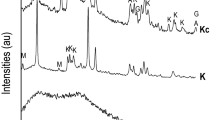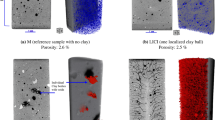Abstract
LARGE quantities of Portland cement are used annually for the stabilization of soils for roads, airfields, and other engineering works. While the improvement in engineering properties effected by cement treatment is believed due mainly to the hardening of cement, reactions between hydrating cement and clays leading to the formation of additional cementitious material have been suggested1.
This is a preview of subscription content, access via your institution
Access options
Subscribe to this journal
Receive 51 print issues and online access
$199.00 per year
only $3.90 per issue
Buy this article
- Purchase on Springer Link
- Instant access to full article PDF
Prices may be subject to local taxes which are calculated during checkout
Similar content being viewed by others
References
Lambe, T. W., Michaels, A. S., and Moh, Z. C., Highway Res. Board Bull., 241 (1960).
Lea, F. M., and Desch, C. H., The Chemistry of Cement and Concrete (Arnold, London, 1956).
Grim, R. E., Clay Mineralogy (McGraw-Hill, New York, 1953).
Eades, J. L., and Grim, R. D., Highway Res. Board Bull., 262 (1960).
Author information
Authors and Affiliations
Rights and permissions
About this article
Cite this article
HERZOG, A., MITCHELL, J. X-ray Evidence for Cement-Clay Interaction. Nature 195, 989–990 (1962). https://doi.org/10.1038/195989a0
Issue Date:
DOI: https://doi.org/10.1038/195989a0
Comments
By submitting a comment you agree to abide by our Terms and Community Guidelines. If you find something abusive or that does not comply with our terms or guidelines please flag it as inappropriate.



